The smart electric drive market is estimated to be valued at USD 4.28 billion in 2025 and is expected to reach USD 29.25 billion by 2032, growing at a compound annual growth rate (CAGR) of 31.6% from 2025 to 2032.
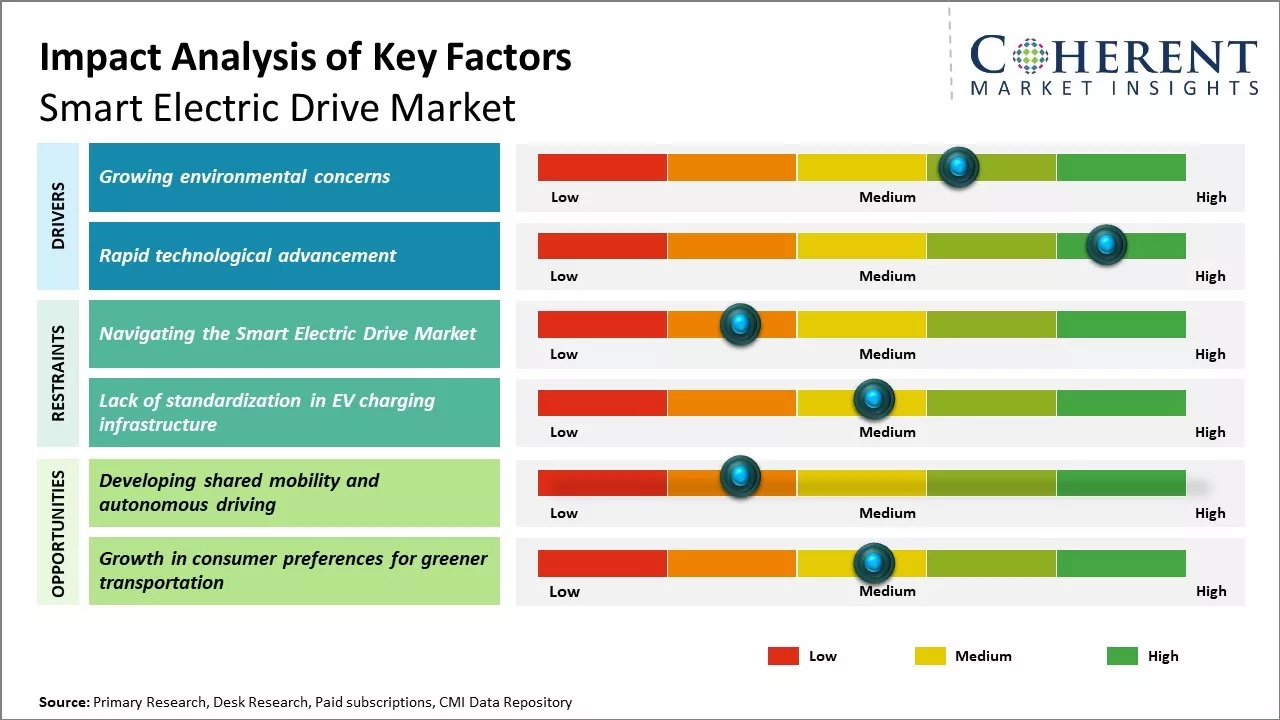
Discover market dynamics shaping the industry: Request sample copy
The adoption of electric vehicles is expected to drive the demand for smart electric drive technologies. Stringent emission norms by governments across the globe and rising environmental concerns are compelling automotive manufacturers to increase their focus on developing electric and hybrid vehicles. Additionally, decreasing prices of lithium-ion batteries along with increasing investments by leading automakers in electric vehicle manufacturing is anticipated to boost the smart electric drive market growth over the forecast period. Continued product innovations to improve vehicle range and develop fast charging technologies will further escalate the uptake of smart electric drives in battery-powered vehicles.
Growing environmental concerns
With increasing pollution levels and climate change becoming big concerns for governments and general public across the globe, electric vehicles are seen as one way to reduce emissions. While technology plays a big role in enabling greater adoption of electric vehicles, consumer mindset and policy push also drives the smart electric drive market. More and more people are realizing personal transport's role in degrading air quality and its impact on global warming. Strict emission regulations on vehicles coupled with financial incentives are nudging customers towards electric vehicles. Automakers too are actively pushing electric vehicle development to align with global sustainability goals. Customers looking to minimize their carbon footprint and do their bit for the environment are willing to pay more for electric vehicles despite them currently being more expensive than conventional vehicles. Rapid expansion of charging infrastructure is also boosting confidence in electric vehicles. The lifestyle change towards green mobility seems irreversible and is a key driver behind the rising interest in smart electric drive systems.
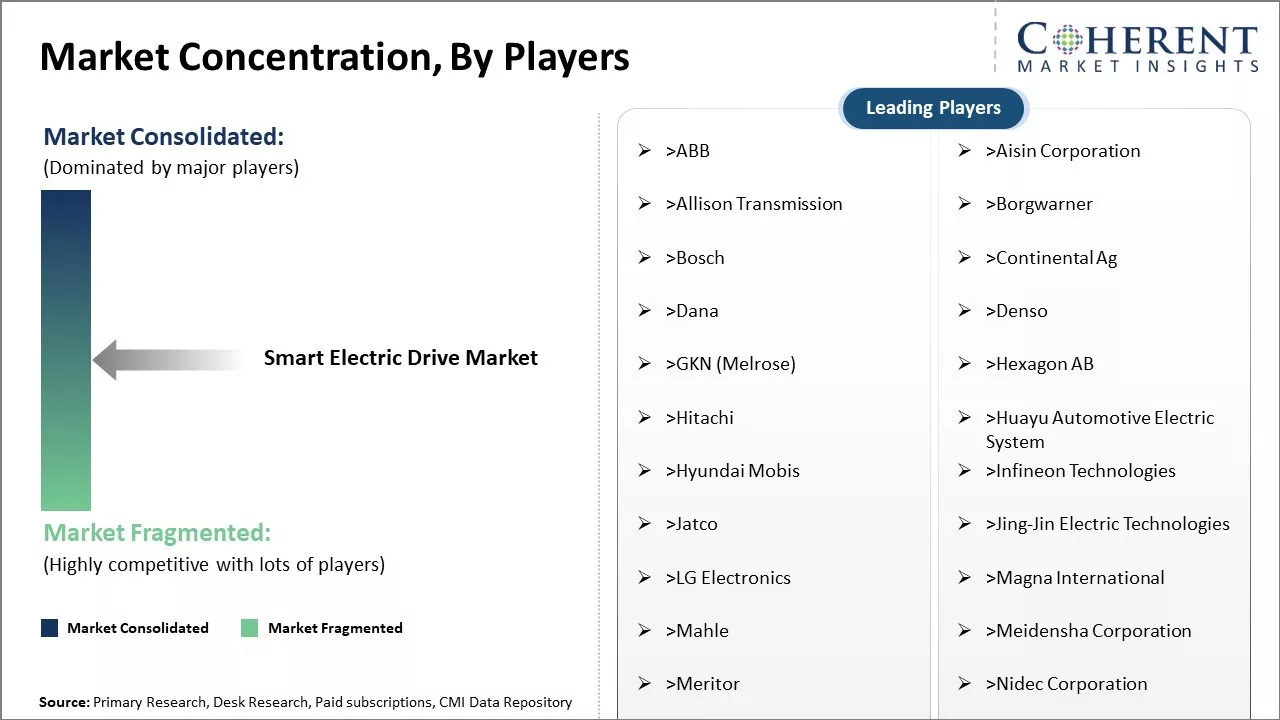
Get actionable strategies to beat competition: Request sample copy
Rapid technological advancements
The smart electric drive market is undergoing tremendous change led by continuous innovations in automotive electrification. Lithium-ion battery technology in particular has evolved at a drastic pace enabling increased driving range in electric vehicles. Where initially an Electric Vehicle could travel only 100-150 km on a single charge, now vehicles capable of going over 500 km are becoming available. This has drastically reduced range anxiety which was a big psychological barrier for customers. Likewise, traction motors capable of providing higher torque right from zero rpm for performance driving have become commonplace. Advancements are also happening in power electronics used in electric vehicles with more efficient and compact solutions coming up. The software and connectivity side is also getting stronger with over-the-air updates and data-driven personalized services. Customers today expect their electric vehicles to match internal combustion engine vehicles in performance while transitioning to new mobility experiences. This places the onus on automakers to rapidly advance their electric drive technologies through continuous innovations. As new generations of advanced batteries and electric powertrains emerge in coming years, their widespread adoption will further stimulate the demand for smart electric drive systems.
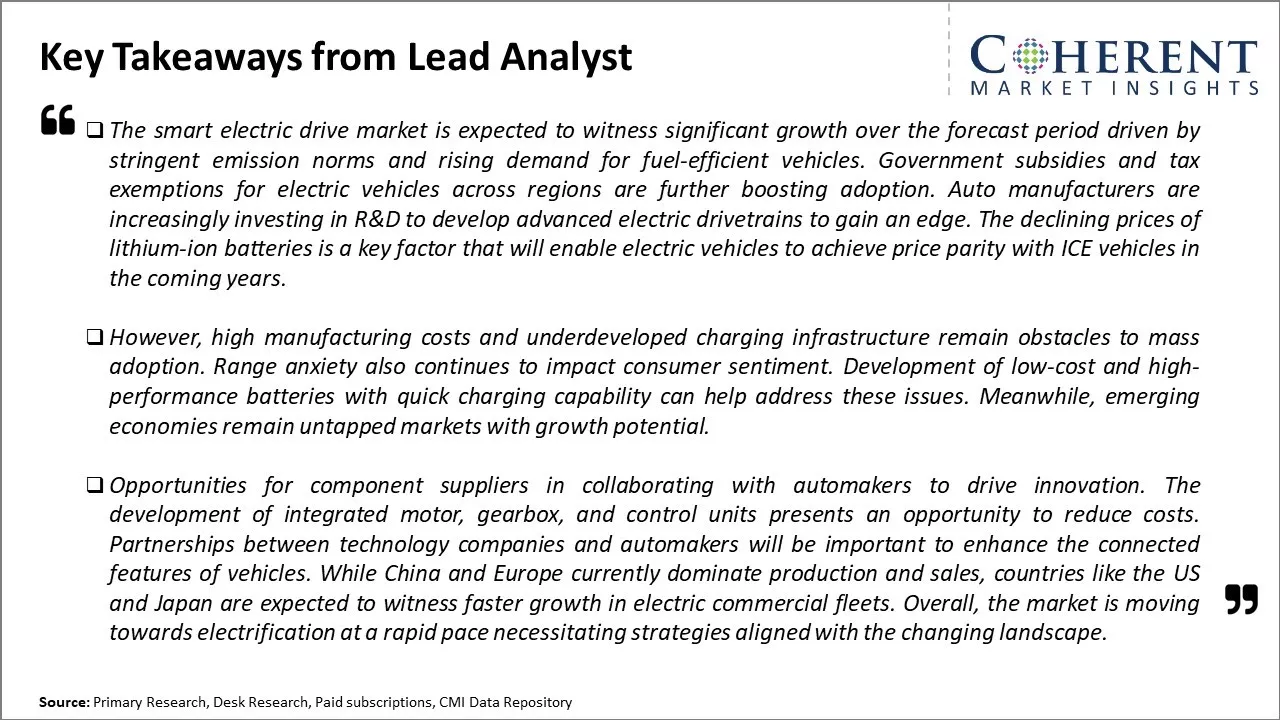
To learn more about this report, Request sample copy
Market Challenges: Navigating the Smart Electric Drive Market
The smart electric drive market faces several challenges. Established automakers are reluctant to shift entirely to electric vehicles which require huge capital investments. The limited driving range of EVs and lack of public charging stations deters customers. Battery costs remain high while technologies like autonomous driving require further testing and regulation. Moreover, changing customer preferences and declining demand amid a global recession can negatively impact sales.
Market Opportunities:
However, the market also presents substantial opportunities. Global concerns over environmental protection are driving stricter emissions regulations and incentives for EV adoption. Advancements in battery technology are improving energy density and lowering costs. As more chargers are installed, range anxiety will lessen. Young environmentally-conscious customers are eager to buy EVs. Autonomous and connected features will enhance the driver experience, attracting new demographics. With more models available, competition will intensify and costs decline, benefiting consumers.
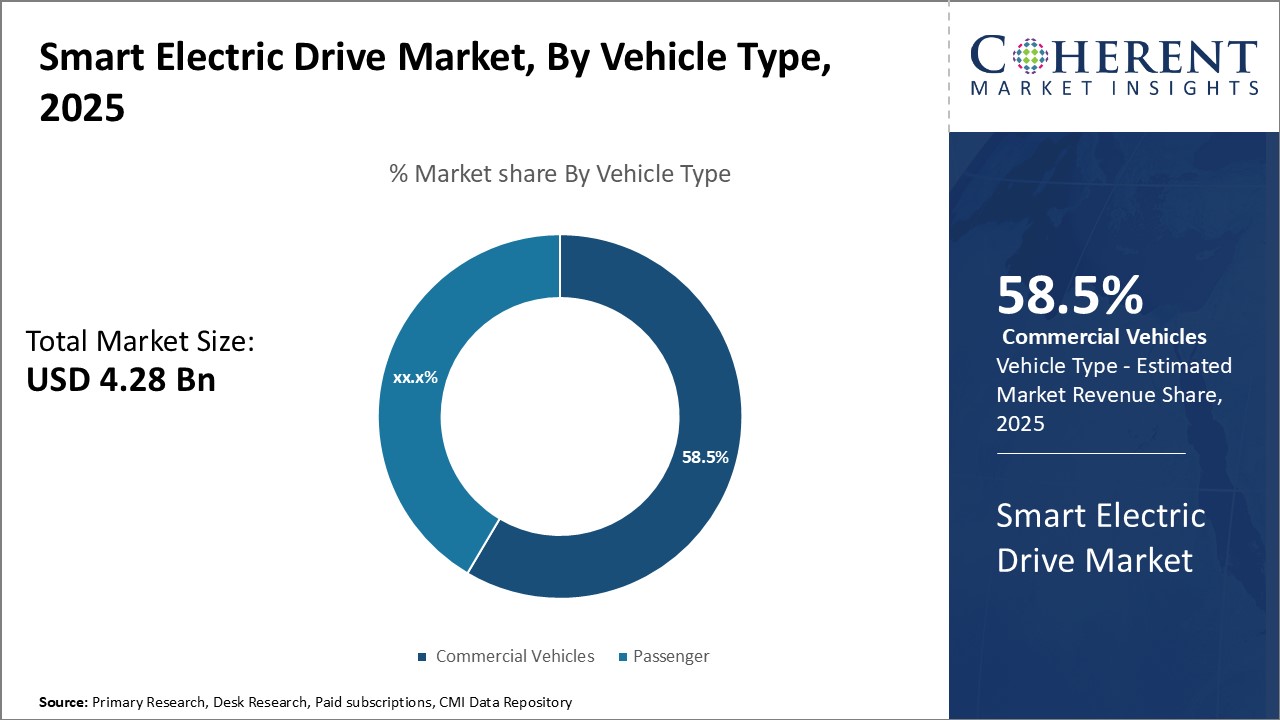
Discover high revenue pocket segments and roadmap to it: Request sample copy
Insights By Vehicle Type- Rise of eco-friendly transportation fuels the commercial segment growth
In terms of vehicle type, commercial vehicles contribute the highest share of the market owing 58.5% in 2025 to the growing demand for eco-friendly and low-cost fleet transportation. Commercial electric vehicles offer significant benefits compared to conventional fuel-powered trucks and vans used in delivery, service, and transportation industries. The upfront costs of electric commercial vehicles are steadily declining as battery technologies advance. With lower operating and maintenance expenses, electric trucks and vans are proving far more economical over the lifespan of the vehicle.
Commercial operators are under mounting pressure to reduce their carbon footprint and transition to greener fleets. Many cities and states are implementing emission regulations and restrictions on diesel vehicles to improve the air quality. All-electric commercial vehicles eliminate tailpipe emissions entirely, allowing companies to meet sustainability goals while avoiding penalties. Government subsidies and tax incentives are encouraging more businesses to make the switch to electric commercial fleets.
The benefits of electric drive extend well beyond environmental impacts. Electric powertrains are simpler to manufacture and maintain compared to internal combustion and require far fewer moving parts. This translates to greater uptime and reliability which is crucial for commercial operations that depend on vehicle availability. The quiet, vibration-free drive of electric vehicles also creates a more comfortable work environment for drivers. With advances in fast charging infrastructure, range anxiety has ceased to be a challenge even for long-haul applications.
Large logistics companies and parcel delivery services are leading the electrification of commercial transportation. As costs decline and capabilities rise, the rest of the industry will certainly follow to gain these operational efficiencies and competitive advantages. This will propel further growth in the commercial electric vehicle segment in the coming years.
Insights By Electric Drive- Battery technology drives battery electric vehicle dominance
In terms of electric drive, battery EV contributes the highest share of the market owing 48.2% in 2025 due to revolutionary improvements in battery energy density and power. Lithium-ion battery technology has advanced rapidly, enabling battery-powered vehicles to achieve performance parity with gasoline cars. Batteries can now store significantly more energy in a smaller and lighter package, with higher recharge rates and cycle life. This has eliminated many of the drawbacks that hindered early battery electric vehicles.
Automakers have rushed to launch new battery electric models as batteries have gotten better and cheaper to manufacture at scale. Customers can now choose from a growing variety of long-range BEVs from most major brands, matching or exceeding the range of comparable gasoline cars. With minimal maintenance costs and no need to refuel with expensive gasoline, the total cost of ownership of BEVs is very competitive even before any government incentives. Their simplicity, instant torque, and silent operation have also made them an attractive option.
Charging infrastructure has notably improved, with DC fast chargers now allowing drivers to top up in minutes rather than hours. Most public charge points are compatible with all BEV brands. Thousands of new fast chargers are being deployed each year along highways and in cities across most nations to support longer trips. As charging networks expand further, range anxiety will entirely disappear.
With battery packs dominating electric vehicle technology, automakers have little incentive to pursue competing drivetrains that require costly hydrogen fueling infrastructure. Improvements in battery chemistry will continue to extend driving ranges and reduce costs down to fuel engine parity, ensuring BEVs remain the electric vehicle of choice.
Insights By, Component- Battery innovations drive electric components market
In terms of component, battery contributes the highest share of the market owing 32.9% in 2025 due to the rapid evolution of battery technology powering the electric vehicle revolution. Continued advances in battery materials, cell chemistry and pack design are driving immense innovation across the entire electric components industry.
Lithium-ion battery energy density has doubled over the past decade through modifications to cathode and anode composition. The switch from liquid to solid-state electrolytes promises even higher capacities. Startups are exploring lithium-sulfur and lithium-air chemistries that could extend ranges far beyond 500 miles. Battery costs have plunged over 80% since 2008 due to the rise of large-scale manufacturing and new extraction methods for battery materials like cobalt, lithium and nickel.
To support higher charging speeds, cell-to-pack designs are replacing pouches and cylindrical cells. Silicon-carbon composites and lithium-titanate anodes improve charging rates to 80% in under 15 minutes. Battery management systems employ AI and hundreds of sensors to gauge temperatures, voltages and currents of individual cells. Liquid cooling systems maintain optimal thermal conditions. Pack structures are evolving to aluminum-foam instead of heavy steel to lower weight.
New inverter topologies minimize power losses and boost electric motor efficiency, while retrofitting existing engines. Silicon carbide semiconductors allow for smaller, more durable inverters. Advancements in Electric Drive Units tightly integrate the motor, gearbox and inverter. Sophisticated motor control software maximizes torque delivery.
As batteries assume center stage, the entire electric motor, power electronics, and charging ecosystem must continuously innovate to fully utilize new battery capabilities. This will sustain explosive growth across EV components in the decade ahead.
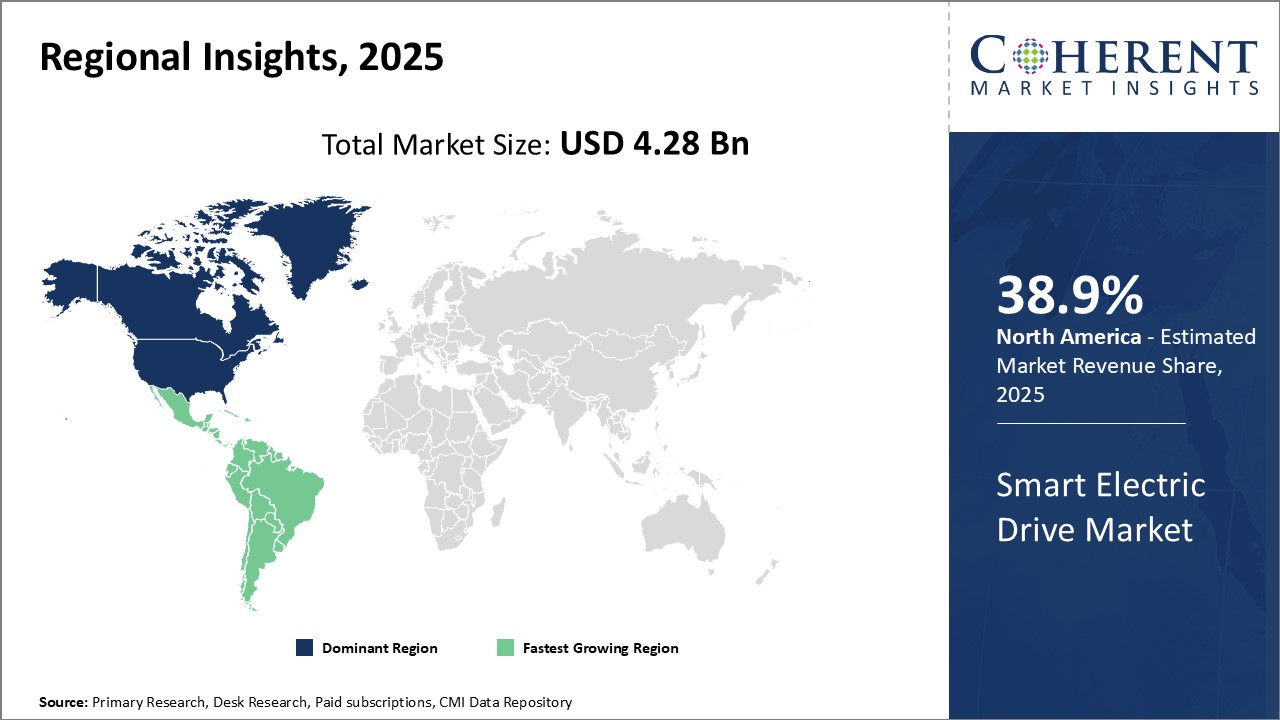
Need a Different Region or Segment? Customize now
North America has established itself as the dominant region owing 38.9% market share in 2025 in the global smart electric drive market. The large presence of automotive giants like General Motors, Ford, and Tesla have propelled research and development activities in the region. With tough emission regulations and higher environmental awareness, automakers in the U.S. and Canada are focused on developing fuel-efficient and eco-friendly vehicles. This has resulted in North America having the highest adoption rate of smart electric drive technologies in commercial and passenger vehicles. Moreover, the region's automotive aftermarket is also well-developed, ensuring steady demand for smart electric drive replacements and upgrades.
The automotive manufacturing industry in Mexico is steadily growing and contributing to the regional market size. Various global automakers have set up manufacturing plants in Mexico to cater to the North American market. This has increased the accessibility of electric vehicles in the country. The favorable investment environment and free trade agreements have supported Mexico in emerging as an important exporter of smart electric drive systems to Latin American countries.
Meanwhile, the Asia Pacific region is witnessing the fastest growth and is emerging as the next hotspot for the smart electric drive market. With strong government support through subsidies and initiatives, China has established a dominant foothold in the commercial electric vehicle segment. Similarly, countries like Japan and South Korea already have a robust automotive industry and are now shifting focus towards developing electric and hybrid vehicles. The presence of leading battery manufacturers and electronic component suppliers in the region has created a conducive supply chain ecosystem for OEMs. This has boosted the large-scale adoption of smart electric drives in passenger cars and other vehicle categories.
Countries like India are also taking conscious efforts to promote electric mobility. The rising emission levels has compelled these nations to take noticeable steps towards building electric vehicle infrastructure and lowering import duties on EV parts. This has attracted investments from global automakers and component manufactures looking to tap into the lucrative and fast-growing Indian market. The focus on developing cost-effective solutions suitable for local conditions is driving innovation and cementing Asia Pacific's position as the front-runner in the smart electric drive industry.
Smart Electric Drive Market Report Coverage
| Report Coverage | Details | ||
|---|---|---|---|
| Base Year: | 2024 | Market Size in 2025: | USD 4.28 Bn |
| Historical Data for: | 2020 To 2024 | Forecast Period: | 2025 To 2032 |
| Forecast Period 2025 to 2032 CAGR: | 31.6% | 2032 Value Projection: | USD 29.25 Bn |
| Geographies covered: |
|
||
| Segments covered: |
|
||
| Companies covered: |
ABB, Aisin Corporation, Allison Transmission, Borgwarner, Bosch, Continental Ag, Dana, Denso, GKN (Melrose), Hexagon AB, Hitachi, Huayu Automotive Electric System, Hyundai Mobis, Infineon Technologies, Jatco, Jing-Jin Electric Technologies, LG Electronics, Magna International, Mahle, Meidensha Corporation, Meritor, Nidec Corporation, Shanghai Automotive Smart Electric Drive, Siemens AG, Smesh E-Axle, and ZF Group |
||
| Growth Drivers: |
|
||
| Restraints & Challenges: |
|
||
Uncover macros and micros vetted on 75+ parameters: Get instant access to report
*Definition: The smart electric drive market consists of companies that develop advanced electric drive technologies to improve the efficiency, performance, and safety of electric vehicles. This includes electric motors, power electronics, and software solutions that optimize power delivery and integration with vehicle systems. The smart electric drive solutions aim to enhance acceleration and drivability while extending vehicle range through energy recuperation and minimization of power losses during driving. These technologies make electric vehicles more affordable and practical for everyday use.
Share
Share
About Author
Gautam Mahajan is a Research Consultant with 5+ years of experience in market research and consulting. He excels in analyzing market engineering, market trends, competitive landscapes, and technological developments. He specializes in both primary and secondary research, as well as strategic consulting across diverse sectors.
Missing comfort of reading report in your local language? Find your preferred language :
Transform your Strategy with Exclusive Trending Reports :
Frequently Asked Questions
Joining thousands of companies around the world committed to making the Excellent Business Solutions.
View All Our Clients
US Reciprocal Tax Impact Analysis On Smart Electric Drive Market
Stay updated on tariff changes with expert insights and timely information